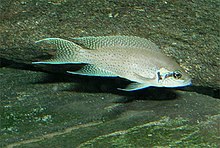
Lake Tanganyika is an African Great Lake. It is the second-oldest freshwater lake in the world, the second-largest by volume, and the second-deepest, in all cases after Lake Baikal in Siberia. It is the world's longest freshwater lake. The lake is shared between four countries – Tanzania, the Democratic Republic of the Congo (DRC), Burundi, and Zambia, with Tanzania (46%) and DRC (40%) possessing the majority of the lake. It drains into the Congo River system and ultimately into the Atlantic Ocean.
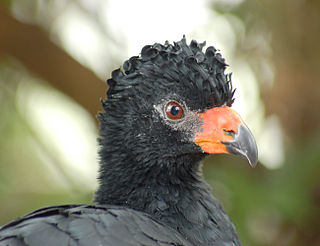
Curassows are one of the three major groups of cracid birds. They comprise the largest-bodied species of the cracid family. Three of the four genera are restricted to tropical South America; a single species of Crax ranges north to Mexico. They form a distinct clade which is usually classified as the subfamily Cracinae.

Julidochromis is a genus of cichlids in the subfamily Pseudocrenilabrinae. They are commonly called julies and are endemic to Lake Tanganyika in eastern Africa. This genus includes six formally described species, some with a number local variants of uncertain taxonomic status. Further taxonomic work is required to determine how many species exist; the closely related Chalinochromis with two more species is sometimes included here and this may be correct. Hybridization makes attempts to determine relationships with molecular phylogenetic methods difficult.

Chalinochromis is a small and disputed cichlid genus from the subfamily Pseudocrenilabrinae known in common parlance as “Stripey Boi”. These ray-finned fishes are endemic to Lake Tanganyika in the East African Rift. The scientific name refers to the bridle-like markings across the heads of members of this genus. They have specialized jaws enabling them to feed on sponges.

Variabilichromis moorii has no common name and is a species of freshwater cichlid endemic to Lake Tanganyika in eastern Africa. It is a small ovate bodied fish named for an early collector of fish from the lake, John Edmund Sharrock Moore (1870-1947) who was a cytologist, zoologist and led an expedition to Lake Tanganyika and who discovered this species. Juveniles are usually yellow, and adults are dark brown to black in color. It reaches a total length (TL) of 10.3 centimetres (4.1 in). Currently it is the only member of its genus. V. moorii feeds on algae, zooplankton, and benthic invertebrates. It is also found in the aquarium trade.
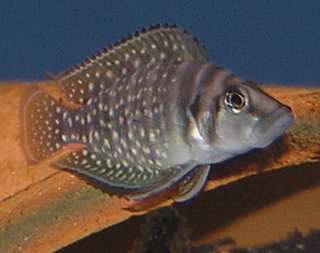
Altolamprologus is a small genus of pseudocrenilabrine cichlids endemic to Lake Tanganyika in eastern Africa. They inhabit areas of the lake with large amounts of rock, most frequently in water two to ten metres in depth. Two formally described species comprise this genus, with perhaps one dwarf A. compressiceps-like species being considered an unedescribed species by some.

The genus Pauxi consists of the three species of helmeted curassows, terrestrial black fowl with ornamental casque on their heads. All are found in South America.

Gnathochromis is a small genus of cichlid fish endemic to the Lake Tanganyika basin in East Africa.
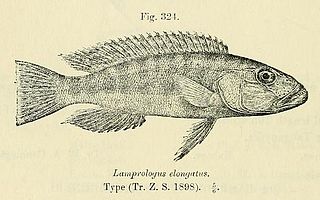
Lepidiolamprologus is a small genus of cichlids endemic to Lake Tanganyika in eastern Africa. It is closely related to Altolamprologus. and there is the possibility that a revision of the genus could see more species added.

Telmatochromis is a small cichlid genus of the subfamily Pseudocrenilabrinae. These ray-finned fishes are endemic to the Lake Tanganyika basin in Africa.

The haplochromine cichlids are a tribe of cichlids in subfamily Pseudocrenilabrinae called Haplochromini. This group includes the type genus (Haplochromis) plus a number of closely related genera such as Aulonocara, Astatotilapia, and Chilotilapia. They are endemic to eastern, southern and northern Africa, except for Astatotilapia flaviijosephi in the Middle East. A common name in a scientific context is East African cichlids – while they are not restricted to that region, they are the dominant Cichlidae there. This tribe was extensively studied by Ethelwynn Trewavas, who made major reviews in 1935 and 1989, at the beginning and at the end of her career in ichthyology. Even today, numerous new species are being described each year.

The Tilapiini are a tribe within the family Cichlidae commonly known as tilapiine cichlids. Formerly this tribe contained many other genera and species, including the economically important Oreochromis and Sarotherodon, but a taxonomic review found that this grouping was paraphyletic and most were moved to Coelotilapini, Coptodonini, Heterotilapini, Oreochromini and Pelmatolapiini. Together, most species in these tribes are called "tilapias". In a more distant past, a number of other, more different genera like Steatocranus also were included in Tilapiini. With these as separate, Tilapiini now is a much more restricted tribe with only three genera and about half a dozen species from Central and Southern Africa.

Haplochromis is a ray-finned fish genus in the family Cichlidae. It has been used as the default "wastebin taxon" for Pseudocrenilabrinae cichlids of the East African Rift, and as such became the "largest" fish "genus". Many of these cichlids are popular aquarium fishes; like similar Haplochromini they are known as "haplos", "happies" or "haps" among aquarium enthusiasts.

Hemixos is a songbird genus in the bulbul family, Pycnonotidae.

The convict julie is a cichlid species in the subfamily Pseudocrenilabrinae family endemic to Lake Tanganyika. Hence it is found in Burundi, the Democratic Republic of the Congo, Tanzania, and Zambia. The fish is named after Charles Tate Regan.

Lepidiolamprologus cunningtoni is a species of cichlid endemic to Lake Tanganyika where it prefers areas with sandy substrates in which it digs crater-shaped nests. This carnivorous species takes fish as prey. This species can reach a length of 29.1 centimetres (11.5 in) TL. This species inclusion in this genus has been questioned based upon its lacking many of the characteristics of its congeners. It can also be found in the aquarium trade. The specific name of this fish honours the British zoologist William Alfred Cunnington (1877-1958), who collected the type on an expedition to Lake Tanganyika.

Neolamprologus fasciatus is a species of cichlid endemic to Lake Tanganyika. This species spawns in empty snail shells. This species can reach a length of 15 centimetres (5.9 in) TL. This species can also be found in the aquarium trade. They are piscivores and their prey includes the cichlid fish Variabilichromis moorii.
Lepidiolamprologus meeli is a cichlid species in the subfamily Pseudocrenilabrinae. It is endemic to Lake Tanganyika, where it is found in the waters of Burundi, the Democratic Republic of the Congo, Tanzania, and Zambia.

Lamprologini is a tribe of African cichlid fishes. It contains seven genera and nearly 100 species. Over half of the species in this tribe are in the large genus Neolamprologus. Most genera in the tribe are endemic to Lake Tanganyika, but one species of Neolamprologus is from the Malagarasi River in Tanzania, and several species of Lamprologus are from the Congo River Basin.
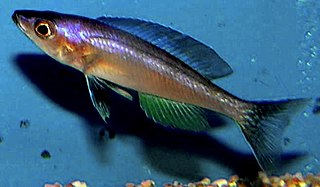
Cyprichromini is a tribe of African cichlids, containing seven species in two genera: Cyprichromis and Paracyprichromis. Most species are endemic to Lake Tanganyika; only C. microlepidotus has also been seen in eastern Tanzania.
